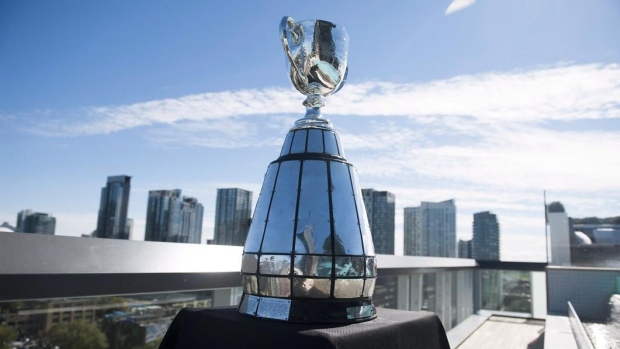Nov 18, 2020
A century later, Canadian football lands in familiar territory
The start of the 1920s was a trying time for Canadian football – no Grey Cup game was played from 1916-1919 – with so much ambiguity about its future. Once again, 100 years later, the game finds itself in an eerily similar place, Dave Naylor writes.
By Dave Naylor

A fall without a Grey Cup game.
It feels strange, a Canadian tradition that dates back more than 100 years missing from the calendar in 2020 due to the COVID-19 pandemic.
Although it’s not the first time this tradition has been interrupted.
It’s hard to imagine what the world was like the last time Lord Grey’s mug wasn’t handed out from 1916-1919.
Those were early days for Canadian football, which began awarding the Grey Cup in 1909 for what was then a championship contested by university and amateur clubs in Ontario and Quebec.
What was then called the Dominion Senior Football Championship involved three leagues – with the winner of the Interprovincial Rugby Football Union (IRFU, or Big 4, consisting of Montreal AAA, Hamilton Tigers, Ottawa and Toronto), playing the winner of the Ontario Rugby Football Union and the collegiate champion.
Much of the scoring in those days came off singles, so a good kicker was far more important than a good passer. In fact, a good passer got you nowhere because the forward pass was still illegal.
While no one back then referred to the championship as the Grey Cup game, there was definitely a void on the national sporting calendar when the First World War suspended play from 1916-18.
The fall of 1918 marked not just the end of the First World War, but the arrival of the Spanish Flu, which killed 50,000 Canadians.
It was all beyond anyone’s control.
But what happened in 1919 was not.
By that year most of Canada was on the road to getting back on its feet, including the resumption of playing football.
In the semifinals that season, McGill defeated the University of Toronto to win the collegiate championship. And Montreal defeated Hamilton to capture the Big Four.
The winner of that game was to play Toronto Rowing AA, the ORFU winner.
But when it came to scheduling the game, the Montreal and McGill players simply decided not to play it.
The McGill players were consumed with schoolwork. The Montreal players had jobs and businesses to worry about, with 19 of them having just returned from the war.
They were just too darned busy. Yes, that’s what really happened.
Toronto Rowing AA wasn’t at all happy about this and invited the University of Toronto (which had lost to McGill) to play for the Cup. But the U of T declined, putting a quiet finishing touch on the 1919 season, sans Grey Cup.
It’s hard to know what the people of those days were thinking, but we can assume that four years without a Grey Cup game gave them lots of time to think about the future of the sport and the championship.
Football was important to Canadians and it was clear the game needed modernization.
So it’s no coincidence that a wave of changes followed the great Grey Cup interruption, which tilted the evolution of the sport forever in the direction of what we know today.
It turns out the 1920s was an incredible decade for Canadian football, representing a shift to offence, rule changes and a series of admissions and innovations to the game. The goal being to open up the game from five yards and a cloud of dust to something more exciting.
One of the most significant changes was the professionalization of the game. The players were in fact becoming professionals, being paid, a necessary innovation when the 1919 experience illustrated flaws in the amateurism model.
By 1921 there are already all kinds of changes being implemented in the game.
Canadian football goes from having 14 players a side on the field to 12 per side, as it has been ever since.
Instead of plays beginning with a heel-back, with a player pushing the ball backwards to the quarterback with his heel, we have the introduction of the snap from centre.
And free substitutions become the norm, allowing players to leave a game and return, leading to the development of situational players.
The 1921 season also represents the first time that a team from Western Canada was allowed to play for the Grey Cup, with Edmonton making the trek east where they lost to Toronto. Teams in the West were then considered inferior to the East, with no team winning the Cup until 1935.
Blocking rules were also unified with those from the west to create a more offensive game.
By the mid-20s, teams were huddling for the first time, and there was signal-calling. And by 1929 we had the introduction of the forward pass.
It’s also the time that the first American players were sanctioned, although it’s believed some may have played masquerading as Canadians prior to that. By 1936, Canadian football had official import limits on American players, a restriction that exists right to today.
By the end of the 1920s, the Grey Cup game was being broadcast on radio and the sport’s popularity was on the ascent.
No doubt the start of the 1920s was an uncertain time for Canadian football, with no Grey Cup game played for four consecutive seasons and so much ambiguity about its future.
Once again, a century later, Canadian football finds itself in an eerily similar place.
And we await to find what permanent changes these ‘20s might deliver.
*Note: A special acknowledgement to Steve Daniel, who up until recently was the CFL’s Senior Director of Game Information and Statistics, for walking me through the early history of the league for this column.

